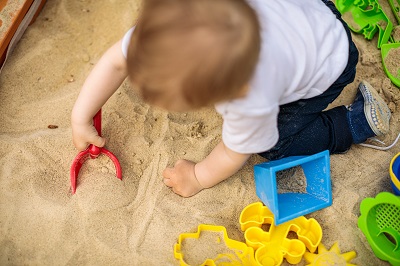10 Ways Mud and Sand Play Boost Development
Most young children love to get messy and dirty. They cannot resist stomping through a mudpuddle or digging holes in the sand. Some kiddos, however, are hesitant to touch icky mud or sticky sand. For those babies, it is vital to introduce them to these natural substances. They may never love them, but they need to tolerate them. As an aside, adults have things we do not enjoy, but we learn to deal with them, such as touching slime or pond algae. Helping your child play in the mud and/or sand helps them tremendously, so let’s get started.
Here are ten ways that playing in the mud or sand can boost your child’s development:
- More tolerance for touching different things – Youngsters are wired to feel and experience the world. These interactions teach your baby characteristics such as temperatures, textures, smells, weights, and more. While they may dislike some of these things, it is helpful for them to tolerate these unpleasantries. For example, I cringe when touching pond algae but if I had to swim through it to save my life, I could. Nature offers many such challenges and your child should experience as many safe touching experiences as possible. Take trips to the beach or let your child have a muddy play area in the backyard. Let them get messy.
- More hand and arm strength – Digging holes in the sand or mud enhance hand and arm strength. Squeezing brown earth into balls or patting it into a pie improves dexterity. Hands and arms get stronger by filling and dumping buckets of sand. Strong hands and arms prepare your child for climbing, riding bicycles, and upcoming participation in sports.
- Learn words for different sensations – Talk through what your child is feeling to build their vocabulary. Some suggestions to get you started are, “This mud is warm and slimy” or “Beach sand is gritty and grainy. It does not stick together as well as mud, does it?” You know what gritty sand and sticky mud feel like. You have memories of those sensations that are matched with vocabulary words. Your child needs those same memories to associate with words.
- Learn words for different actions – Similar to #3 above. “Let’s dig this mud and make a big hole for the dog to play in” or “You built a big mountain of sand now climb on top of it.” Children need to learn verbs, not just nouns.
- Learn words for different playthings – “Grab your shovel and let’s dig” or “Let’s dip this muddy water into the bucket using a spoon.” Again, narrating and labeling increase your baby’s vocabulary. You can also use descriptors, such as a yellow shovel or tiny spoon.
- Strengthen the core and legs – Walking through the mudhole or up and down the sand pile strengthens bodies and legs. You have walked through deep sand or bogged down in the mud so you recall how much effort it took to walk without falling. Your child also needs the strength to enjoy strolling in the sand or hiking out of the woods when the mud buggy breaks down.
- Improve walking balance – When your child walked across the room, their world expanded exponentially. As their balance improves, offer opportunities outside where the terrain is not level. For example, many modern playgrounds contain sand or pine bark. These mushy, squishy, and unstable surfaces that are meant to prevent injuries provide challenging terrain for your child to walk and run across.
- Increase creativity and imagination – Nature explodes with beauty and wonder. Your child’s imagination and creativity bloom upon seeing the icky beauty of shell-laden seafoam or the rainbow-colored reflection in the parking lot puddle. Painting or building things they have seen in nature fosters your budding artist, writer, or builder. Pretend and imaginative play are signs of healthy cognitive development.
- Improve mood – Many busy children need sensory experiences. Their little bodies seek those. If not allowed to explore, your tot can become moody and difficult. To improve their mood, get them outside digging in the sandbox or making mudpies on the back porch. Try finger painting or head to the park. Excessive exposure to electronic screens has been shown to lead to moodiness and crankiness. Turn off those screens and explore nature.
- Healthier appetite and sleep – Many children spend excessive time indoors in small spaces. Youngsters need to run, climb, dig, and burn off energy. Expending energy burns calories. More activity leads to hunger and an improved appetite. Bodies that are tired and calm rest better. Remember those summer days when you played outside almost all day? You ate a lot and slept well.
If your child is hesitant to go outside, build small increments into the daily schedule for playing in the mud and sand. Play with your baby so they see it can be fun and safe. Lessen your workload by providing play clothes for this messy play. Or put them in a swimsuit and hose them off afterwards.
These days in your youngster’s life can be some of the best! Not only are they a time of consequential importance in their development, but fun! When possible, include playmates.
Does your baby enjoy playing in the mud or sand?
Get your FREE copy of Milestone Chart for Moms.
To keep up with the latest tips and ask questions, join us on Instagram at Grow with Ginny or listen on The New Mom Podcast.
(Photo: Adobe Stock )

